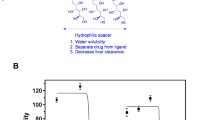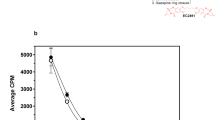Abstract
Purpose: Folate receptor (FR) targeted drug conjugates were prepared by covalently attaching the vitamin folate, to the potent anticancer drug, mitomycin C (MMC). One such conjugate, called EC72, was synthesized with an intramolecular disulfide bond, and it was found to exhibit efficacious anti-tumor activity against FR-expressing M109 tumors in a manner that yielded no gross or microscopic toxicity, even to FR-positive kidneys. Methods: EC72’s specificity was demonstrated by two methods: (1) blocking EC72’s activity with an excess of co-administered folic acid (FA) in M109 tumor bearing mice and (2) the absence of therapeutic activity in mice bearing FR-negative tumors. The importance of having a cleavable bond in the conjugate was also exemplified, since EC110 (a folate–MMC conjugate constructed with a more resilient amide bond) failed to produce anti-M109 tumor activity. EC72’s therapeutic potential was found to decrease with respect to the increasing size of subcutaneous tumor. However, a combination therapy with paclitaxel reproducibly improved the anti-tumor efficacy relative to either agent alone at well tolerated dose levels and with no apparent increase in toxicity. A more advanced folate–MMC conjugate was also synthesized in an effort to improve activity. Thus, EC118, a molecule constructed with both a reducible disulfide bond and an acid-labile hydrazone bond in the linker region, was tested and found to produce a significantly greater number of tumor regressions of more established M109 tumors than that achieved with EC72. Conclusion: Overall, these data indicate that folate-targeted drug therapy alone, or in combination with paclitaxel, may be a novel and effective clinical approach towards treating FR-positive cancers.






Similar content being viewed by others
Notes
4T1 cells are sensitive to MMC.
References
Damle NK, Frost P (2003) Antibody-targeted chemotherapy with immunoconjugates of calicheamicin. Curr Opin Pharmacol 3(4):386–390
Giles F, Estey E, O’Brien S (2003) Gemtuzumab ozogamicin in the treatment of acute myeloid leukemia. Cancer 98(10):2095–2104
Trail PA, Willner D, Lasch SJ, Henderson AJ, Hofstead S, Casazza AM, Firestone RA, Hellstrom I, Hellstrom KE (1993) Cure of xenografted human carcinomas by BR96-doxorubicin immunoconjugates. Science 261(5118):212–215
Tolcher AW, Sugarman S, Gelmon KA, Cohen R, Saleh M, Isaacs C, Young L, Healey D, Onetto N, Slichenmyer W (1999) Randomized phase II study of BR96-doxorubicin conjugate in patients with metastatic breast cancer. J Clin Oncol 17(2):478–484
Liu C, Tadayoni BM, Bourret LA, Mattocks KM, Derr SM, Widdison WC, Kedersha NL, Ariniello PD, Goldmacher VS, Lambert JM, Blattler WA, Chari RV (1996) Eradication of large colon tumor xenografts by targeted delivery of maytansinoids. Proc Natl Acad Sci USA 93(16):8618–8623
Tolcher AW, Ochoa L, Hammond LA, Patnaik A, Edwards T, Takimoto C, Smith L, de Bono J, Schwartz G, Mays T, Jonak ZL, Johnson R et al (2003) Cantuzumab mertansine, a maytansinoid immunoconjugate directed to the CanAg antigen: a phase I, pharmacokinetic, and biologic correlative study. J Clin Oncol 21(2):211–222
Tassone P, Gozzini A, Goldmacher V, Shammas MA, Whiteman KR, Carrasco DR, Li C, Allam CK, Venuta S, Anderson KC, Munshi NC. (2004) In vitro and in vivo activity of the maytansinoid immunoconjugate huN901-N2′-deacetyl-N2′-(3-mercapto-1-oxopropyl)-maytansine against CD56+ multiple myeloma cells. Cancer Res 64(13):4629–4636
Chari RV, Jackel KA, Bourret LA, Derr SM, Tadayoni BM, Mattocks KM, Shah SA, Liu C, Blattler WA, Goldmacher VS (1995) Enhancement of the selectivity and antitumor efficacy of a CC-1065 analogue through immunoconjugate formation. Cancer Res 55(18):4079–4084
Jain RK (2001) Delivery of molecular and cellular medicine to solid tumors. Adv Drug Deliv Rev 46(1–3):149–168
Reddy JA, Allagadda VM, Leamon CP (2005) Targeting therapeutic and imaging agents to folate receptor positive tumors. Curr Pharm Biotechnol 6(2):131–150
Reddy JA, Low PS (1998) Folate-mediated targeting of therapeutic and imaging agents to cancers. Crit Rev Ther Drug Carrier Syst 15(6):587–627
Leamon CP, Low PS (2001) Folate-mediated targeting: from diagnostics to drug and gene delivery. Drug Discov Today 6(1):44–51
Weitman SD, Lark RH, Coney LR, Fort DW, Frasca V, Zurawski VR Jr, Kamen BA (1992) Distribution of the folate receptor GP38 in normal and malignant cell lines and tissues. Cancer Res 52(12):3396–3401
Ross JF, Chaudhuri PK, Ratnam M (1994) Differential regulation of folate receptor isoforms in normal and malignant tissues in vivo and in established cell lines. Physiologic and clinical implications. Cancer 73(9):2432–2443
Toffoli G, Cernigoi C, Russo A, Gallo A, Bagnoli M, Boiocchi M (1997) Overexpression of folate binding protein in ovarian cancers. Int J Cancer 74(2):193–198
Leamon CP, Low PS (1991) Delivery of macromolecules into living cells: a method that exploits folate receptor endocytosis. Proc Natl Acad Sci USA 88(13):5572–5576
Leamon CP, Low PS (1993) Membrane folate-binding proteins are responsible for folate–protein conjugate endocytosis into cultured cells. Biochem J 291(Pt 3):855–860
Rund LA, Cho BK, Manning TC, Holler PD, Roy EJ, Kranz DM (1999) Bispecific agents target endogenous murine T cells against human tumor xenografts. Int J Cancer 83(1):141–149
Lu Y, Low PS (2002) Folate targeting of haptens to cancer cell surfaces mediates immunotherapy of syngeneic murine tumors. Cancer Immunol Immunother 51(3):153–162
Lee RJ, Low PS (1994) Delivery of liposomes into cultured KB cells via folate receptor-mediated endocytosis. J Biol Chem 269(5):3198–3204
Reddy JA, Abburi C, Hofland H, Howard SJ, Vlahov I, Wils P, Leamon CP (2002) Folate-targeted, cationic liposome-mediated gene transfer into disseminated peritoneal tumors. Gene Ther 9(22):1542–1550
Reddy JA, Xu LC, Parker N, Vetzel M, Leamon CP (2004) Preclinical evaluation of (99m)Tc-EC20 for imaging folate receptor-positive tumors. J Nucl Med 45(5):857–866
Ladino CA, Chari RV, Bourret LA, Kedersha NL, Goldmacher VS (1997) Folate-maytansinoids: target-selective drugs of low molecular weight. Int J Cancer 73(6):859–864
Leamon CP, Reddy JA, Vlahov IR, Vetzel M, Westrick E (Submitted) Biological evaluation of EC72: A new folate-targeted chemotherapeutic
Bradner WT (2001) Mitomycin C: a clinical update. Cancer Treat Rev 27(1):35–50
Verweij J, Pinedo HM (1990) Mitomycin C: mechanism of action, usefulness and limitations. Anticancer Drugs 1(1):5–13
Mathias CJ, Wang S, Lee RJ, Waters DJ, Low PS, Green MA (1996) Tumor-selective radiopharmaceutical targeting via receptor-mediated endocytosis of gallium-67-deferoxamine-folate. J Nucl Med 37(6):1003–1008
Baker LH, Izbicki RM, Vaitkevicius VK (1976) Phase II study of profiromycin vs mitomycin-C utilizing acute intermittent schedules. Med Pediatr Oncol 2(2):207–213
Ihnat MA, Lariviere JP, Warren AJ, La Ronde N, Blaxall JR, Pierre KM, Turpie BW, Hamilton JW (1997) Suppression of P-glycoprotein expression and multidrug resistance by DNA cross-linking agents. Clin Cancer Res 3(8):1339–1346
Maitra R, Halpin PA, Karlson KH, Page RL, Paik DY, Leavitt MO, Moyer BD, Stanton BA, Hamilton JW (2001) Differential effects of mitomycin C and doxorubicin on P-glycoprotein expression. Biochem J 355(Pt 3):617–624
Steinman RM, Mellman IS, Muller WA, Cohn ZA (1983) Endocytosis and the recycling of plasma membrane. J Cell Biol 96(1):1–27
Rose WC (1992) Taxol: a review of its preclinical in vivo antitumor activity. Anticancer Drugs 3(4):311–321
Goldspiel BR (1997) Clinical overview of the taxanes. Pharmacotherapy 17(5 Pt 2):110S–125S
Horwitz SB, Lothstein L, Manfredi JJ, Mellado W, Parness J, Roy SN, Schiff PB, Sorbara L, Zeheb R (1986) Taxol: mechanisms of action and resistance. Ann N Y Acad Sci 466:733–744
Horwitz SB (1994) Taxol (paclitaxel): mechanisms of action. Ann Oncol 5(Suppl 6):S3–S6
Paulos CM, Reddy JA, Leamon CP, Turk MJ, Low PS (2004) Ligand binding and kinetics of folate receptor recycling in vivo: impact on receptor-mediated drug delivery. Mol Pharmacol 66(6):1406–1414
Parker N, Turk MJ, Westrick E, Lewis JD, Low PS, Leamon CP (2005) Folate receptor expression in carcinomas and normal tissues determined by a quantitative radioligand binding assay. Anal Biochem 338(2):284–293
Birn H, Selhub J, Christensen EI (1993) Internalization and intracellular transport of folate-binding protein in rat kidney proximal tubule. Am J Physiol 264(2 Pt 1):C302–C310
Birn H, Nielsen S, Christensen EI (1997) Internalization and apical-to-basolateral transport of folate in rat kidney proximal tubule. Am J Physiol 272(1 Pt 2):F70–F78
Morshed KM, Ross DM, McMartin KE (1997) Folate transport proteins mediate the bidirectional transport of 5-methyltetrahydrofolate in cultured human proximal tubule cells. J Nutr 127(6):1137–1147
Garin-Chesa P, Campbell I, Saigo PE, Lewis JL Jr, Old LJ, Rettig WJ (1993) Trophoblast and ovarian cancer antigen LK26. Sensitivity and specificity in immunopathology and molecular identification as a folate-binding protein. Am J Pathol 142(2):557–567
Hosomi, Ohe Y, Mito K, Uramoto H, Moriyama E, Tanaka K, Kodama K, Niho S, Goto K, Ohmatsu H, Matsumoto T, Hojo F et al (1999) Phase I study of cisplatin and docetaxel plus mitomycin C in patients with metastatic non-small cell lung cancer. Jpn J Clin Oncol 29(11):546–549
Acknowledgements
The authors wish to thank Dr. Philip S. Low for his valuable comments. This work was supported in part by an NIH FLAIR grant #5R44CA096020-03.
Author information
Authors and Affiliations
Corresponding author
Rights and permissions
About this article
Cite this article
Reddy, J.A., Westrick, E., Vlahov, I. et al. Folate receptor specific anti-tumor activity of folate–mitomycin conjugates. Cancer Chemother Pharmacol 58, 229–236 (2006). https://doi.org/10.1007/s00280-005-0151-z
Received:
Accepted:
Published:
Issue Date:
DOI: https://doi.org/10.1007/s00280-005-0151-z




